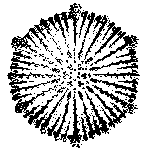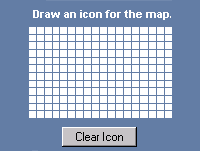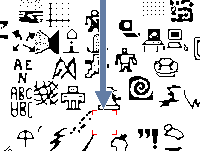 |
 |

World Wide Wunderkammer
A metaphor for mapping social spaces.
The wunderkammer is a cabinet of wonders. Walk into a well-heeled
household in the middle of the 17th century, and you would see proudly displayed a glass cabinet filled with an odd
assortment of devices, say a mammoth tooth, a hat from India, and perhaps a jar of exotic insects from China. The
wunderkammer was a collection of objects, a trigger to the memory, a device that let the mind wander to faraway places.
The wunderkammer was partly a manifestation of the inevitable urge
to collect. (For a fascinating look at the mind of the collector, we highly recommend Bruce Chatwin's
Utz; for an equally fascinating
look from the point of the view of the collectee, you can't do much better than Tibor Fischer's
The Collector Collector.)
But, as digital artists Marek Walczak and Martin Wattenberg realized, the wunderkammer is more than a collection.
The cabinet of wonders is a way of placing objects next to each other to evoke memories, a cabinet of
hyperlinks to a broad set of visual associations.
To these artists, the wunderkammer flows directly from
devices such as the memory palace, a visual structure in your head you use to store and (most importantly)
recall memories.
In their new project, WonderWalker: A Global Online Wunderkammer, Walczak and Wattenberg apply this old
metaphor to the Internet. The results are fascinating. WonderWalker is a visual map of icons. People
create icons and lay those icons in a place that is appropriate on the map. This collective wunderkammer
uses space to find things: you look for something that is related, then place your icon next to it. In a
technical tour-de-force of java programming, this snappy interface can quickly switch from a spatial view
to a timeline, showing which objects were placed when, or to an author-based view. WonderWalker
takes the wunderkammer concept of the collection of curiosities and applies it to the net to create a
new kind of social space.
Social spaces are the subject of an ongoing inquiry
on the net. In Map of the Month (February 2001), Martin Dodge investigates Netscan, a project that attempts to
divine the social space inherent in Usenet News. In WonderWalker, the artists treat the entire
web as a database and, instead of trying to use the structure of the underlying links to divine
social spaces, they invite humans to create the space through their placement of icons.
An interesting and in-depth exploration
of the wunderkammer metaphor is provided by Shiralee Saul in her
Information Tsunami Wunderkammer.
In an accompanying essay,
she explains how she views the Internet as a vast place to explore and her computer as the
place to bring back links to store in her own digital wunderkammer:
 “The Internet is becoming “home” to spaces and places that have no
existence outside of the network. There are islands and palaces of
light, dungeons and hells, friendly wayfarers and endemic flame wars.
In these places we are all immigrants. What we are and how we appear
to others is a product of our intentions not an accident of birth.
These places are still largely unmapped and, perhaps, will become the
context for the adventurers of the 21st century. But these will be
voyages which any of us can go on…and on which each of us will be
Magellan, Mercator and Banks. What marvels will we bring back to add
to our own (computer)
cabinet of curiosities?”
“The Internet is becoming “home” to spaces and places that have no
existence outside of the network. There are islands and palaces of
light, dungeons and hells, friendly wayfarers and endemic flame wars.
In these places we are all immigrants. What we are and how we appear
to others is a product of our intentions not an accident of birth.
These places are still largely unmapped and, perhaps, will become the
context for the adventurers of the 21st century. But these will be
voyages which any of us can go on…and on which each of us will be
Magellan, Mercator and Banks. What marvels will we bring back to add
to our own (computer)
cabinet of curiosities?”
The web site as wunderkammer, a collection
of curios (links), is an analogy that has not escaped those studying the rise in popularity of the weblog.
In Feed,
Julian Dibbell's Idée Fixe, views the
phenomenon through Proto-Blogger John Barger's website as a cabinet of wonders. He depicts a network slowly evolving from
its primordial beginnings into a more advanced museum age, not unlike the unexplored landscape envisioned by Ms. Saul:
“Just so, the Web log reflects our own attempts to assimilate the glut of immaterial data loosed upon us by the "discovery" of the
networked world. And there are surely lessons for us in the parallel. For just as the cabinet of wonders took centuries to evolve into
the more orderly, logically crystalline museum, so it may be a while before the chaos of the Web submits to any very tidy scheme of
organization. If we hoped once to pass immediately from the Web's Wunderkammer era to its museum age—to fly without a hitch from
What's New to Yahoo!—these days we're obliged to recognize that indexes and search engines are themselves barely adequate to the
job of taming the data storm, that grows far faster than their ability to filter it.”
Essentially any collection of links can be considered a wunderkammer when viewed in this context, but
what makes the WonderWalker so intriguing
is the combination of the high concept of the wunderkammer with the careful execution to
create a shared social space that works. This is certainly an experiment worth tracking, perhaps
even adding a link into your own personal cabinet of curiosities.
| Mappa.Mundi Magazine Interviews Marek Walczak |
|
Mappa.Mundi: WonderWalker is a fascinating mapping paradigm in a 2D space. How did your background in 3D visualization help develop the concepts in this project? In your opinion, did a 2D representation prove to be more or less successful?
Marek Walczak: Actually the ideas were based on my architectural education in London by
people like Cedric Price for whom architecture is a kind of temporal resource for human engagement. I
think that form of thinking, inbred for years, is what fascinates me about
this
work, that we can create dataspaces that easily interact and can be shaped
by the person using it. In this case the 3rd dimension is Time.

|

|
The ability to create custom icons to represent mapped items
adds yet a fourth quirky dimension to WonderWalker, allowing
collectors to lend their creativity to the collective interface. |
Say there are at least two interactive states: There are some of a “fixed”
type which exist across the screen and in time, but whose actual
potential growth is known—like many Java painting toys, etc… There are
others that are “open” where there is an unpredictability in their
development. I think that's why its so much fun to see maps of
people-organized virtual spaces.
Mappa.Mundi: In your interview with Gallery 9, you make this observation on your collaborative working process
with Martin Wattenberg: “In everything we do you see a fraction of what we thought had potential.”
Martin goes on to say, “it is a particular constellation from a very large sky.”
What are a few of the ideas that didn't come to fruition? Was it due to limitations with current technologies,
or was it a creative decision?
Marek Walczak: It's more like having a ferment, a fire of ideas that we can draw from. We
looked at “trails” the idea that people leave markers as they navigate the
WonderWalker/web. Also we had this idea of visualizing multiple search
criteria as a kind of cubist map, where the size of each “chamber”
corresponded to the importance of a parameter. Then we fixed on people
making their own icons,
and they became the focus of the map.
Mappa.Mundi: Do you envision WonderWalker scaling to encompass larger spaces?
Marek Walczak: The most open part of the WonderWalker is that we haven't decided yet what
to do as it gets larger. Well, we have several ideas, but we are waiting to
see how the map grows. Stay tuned!
Mappa.Mundi: Elaborate on why “social spaces” succeed as opposed to one master vision or taxonomy of the Internet.
Marek Walczak: As part of the months spent creating the WonderWalker we looked at every
type of mapping visualization we could find. What's interesting is that
since then I haven't gone back to them. And I think of myself as a visual
guy. The “social” example everyone nods their head to is Amazon: you go
there, they tell you of things on sale similar to what you bought before;
every item is reviewed both by “writers” and anyone; the reviewers are
themselves reviewed; they tell you what books other people have bought
similar to the one you are browsing on etc… Sorta kinda like going to your
friend and saying “seen a good movie lately?” By nature we are social
animals, we make judgments not by tags or how well things are mapped, but
by the social network we build around us. From this network,
perhaps, we establish a sense of self. Now the trick is to tap into the
natural tendency of a social person to accept a different network—which is
why everyone nods their heads when you mention Amazon.
Mappa.Mundi: Recently antarcti.ca was released, a visualization of
The Open Directory Project (DMOZ) mapped onto the surface of Antarctica.
It uses two types of visualization, 2D maps (that are similar in technique to Martin's work on SmartMoney's Map of the Market),
and 3D maps (that use an architectural metaphor, a common theme in your work). Does it succeed in either of these metaphors?
Marek Walczak: SmartMoney's Marketmap is very specific, it colorfully maps the changes of
stock values over time, using a farming field-like analogy. When you look at
it, it's like a “gestalt” image, you see the changes instantly. That's why
it's so useful and popular. The Antarctica map simply isn't as immediate, and
so therefore perhaps not as useful? Wait, a couple of times I used WebBrain,
but then I was “surfing” and was interested in the complexity and depth of
the links, and what unusual item they may dredge up—I wouldn't use it as a
search tool. Have you?
Mappa.Mundi: At a fundamental level, DMOZ is a “social space” as it relies on the input of users and the expertise of human editors to keep its data current. How could a visualization of DMOZ enhance it's inherent qualities as a “social space?”
Marek Walczak: It's “social” in the most basic sense, like Google (don't get me wrong,
Google is great). Think of it in human terms, its like receiving a list of
favorite movies from all your friends and relatives, all in plain text
format and unsigned.
So I guess I'm saying that, way before we even get to 3d visualization, 2d
mappings rarely work. Everyone eulogized the Visual Thesaurus when it first
came out, including me, but I never use it. The trick I think is to layer a
more profound socially interactive space with those visualizations.
Where 3d visualization can help is not as a mapping/search facility but as
an aid to memory. Just as in the Memory Palaces that were used as mnemonic
devices in the past, highly sensory stimulating spaces can help “fix” a
person's memory of a site. In our next project called Apartment we already
see that the immersive environment created by simply typing in text
creates a very interesting phenomenal effect. And that I hope will prove
useful.
|
 |